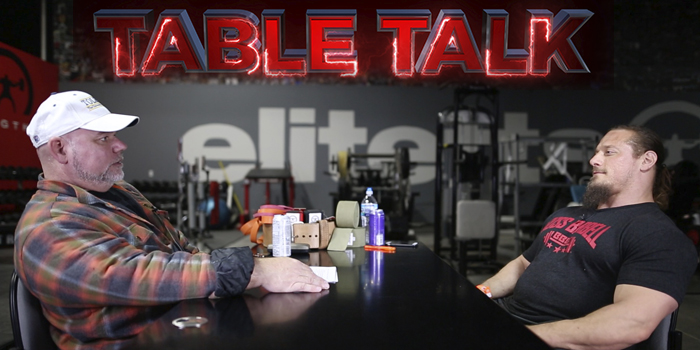
Many lifters who switch from a conventional deadlift stance to a sumo deadlift stance struggle to keep tension in their hips and force their knees out during the movement. Whether due to a mobility issue, a flexibility issue, a stability issue, or a combination of all three, this is a very common problem. For today's Table Talk, Dave Tate and Dan Green respond to a question about positioning for the sumo deadlift:
"Do you have cues for sitting back in the sumo deadlift?"
Before responding to this question, Dave adds an even more important clarifying question:
"Should you sit back in the sumo deadlift?"
Dan begins his answer on the topic of mobility, which he says requires a combination of stabilizing certain joints while having flexibility in other muscles. In the hip, you have the abductors, which are the muscles pushing the hips open and require strength to stabilize the wide position, and the adductors, which need to gain flexibility. It's easy to gain passive flexibility from stretching, but if you gain flexibility in your adductors without strengthening your abductors, you won't see considerable improvement in your sumo deadlift position.
There are a lot of isolation things you can do with your abductors to strengthen them, but if you're looking for the silver bullet Dan recommends turning your attention to block pulls (with the plates elevated three to four inches and you standing at floor height). Sumo deadlifts from blocks can be very helpful for learning to engage your hips with heavy weight in a motion similar to "squatting up" the weight. This exercise will build all of the strength and stabilizing muscles you need to improve your sumo deadlift from the floor.
On the topic of "sitting back" in the sumo deadlift, Dan says to think less of sitting back and think more of keeping the hips as close as possible to the bar in the vertical plane. You don't want them to be low; you want them as far forward as you can. The further your hips push back, the more you load your lower back and the more awkward the position becomes. Better position is always with the hips closer to the bar and the hips higher.
Dave adds that, with the sumo deadlift, moving to blocks and pulling heavier weights can help teach you to strain maximally while also maintaining the mental capacity to keep your technique together. Learning this is incredibly important for powerlifters because, once you're in a meet, you're going to be taking maximal attempts and you need to be able to keep your mind about you. You have to learn that all-out rage under the bar won't work when you hit a sticking point and need to remember how to handle it. Block pulls are really helpful for teaching you this because you're handling more weight and, due to the shortened range of motion, you are less likely to get out of position. You can learn to engage your hips with heavy weight and high tension, which will carry over to your pull from the floor.









